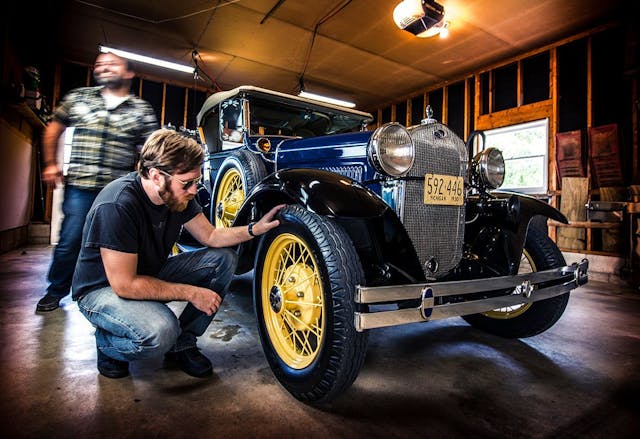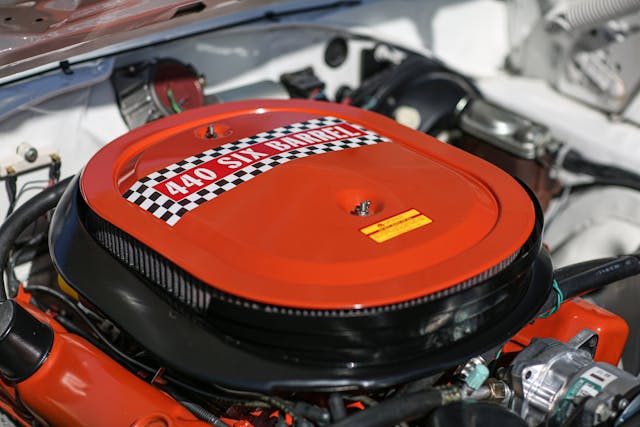6 Critical Post-road Trip Tasks
The final part of any road trip is the sweetest: Arriving at your destination. The final turn of the key is followed by the soft plinking of the engine as it gives off heat to the atmosphere. It’s easy to think that having just finished The Big Drive your car is now ready to go anywhere. And you’re probably right, but if your vintage ride is used like most vintage cars even a short road trip is more use than it typically sees. Taking the time to do a few quick post-road-trip tasks can save you a little time, possibly some money, and definitely some frustration.
Inspect your tires

The only real connection between your car and the road is the round rubber rings at each corner. A quick visual inspection is wise as most vintage vehicles spend more time sitting than driving. A road trip likely put a few months worth of use on those tires in just a few days, so if problems are going to bubble up—literally—it would be at the end of a trip after seeing what could be considered abnormal use. Feel around the tire by hand with a focus on irregularities. Uneven wear is also going to pop up now and get hidden by future short drives, as alignment or similar problems can show up in tire wear after driving longer distances quickly compared to a lot of short trips.
Get the bugs off ASAP

As tempting as it may be to wear those bugs around for a couple of cars and coffee trips to establish dominance over the parking lot princesses, you won’t be doing yourself or your paint any favors. Letting those bug guts bake for any longer than necessary will only make them more work to remove, and aggressive tactics for removal can be very rough on aging paint. Getting things off while still fairly soft and fresh makes for less hassle and impact on your car.
Inspect brakes

Short drives can often hide growing problems and anyone who has experienced sticky calipers knows that a long drive will be when weak points appear. Since you gave the car a good once-over look before your trip—and you did that, right?—you have a good perspective of what things were like before and now will be able to easily spot anything out of the ordinary. Or at least different than when you left. Brakes should last thousands of miles, so any noticeable wear should be easy to spot. Excess brake dust is a simple tell, as is an excess of heat right when the car is parked. Use the back of your hand to take the temperature of the wheel and if it’s enough to be more than warm there is probably something worth investigating before your next drive.
A good chassis lubin’

Did you do a good greasing before you left? Of course you did, becuase you are a good vintage car owner. Maybe just look for signs of excess grease that spilled out from getting too hot or attracted excess dirt and debris. A glob of grease left on a zerk fitting or pushed out from a ball join boot collects road debris and before long transforms from a lubricant to a grinding paste that can ruin a lot of good parts if we aren’t careful. Keep things tidy and if you didn’t grease up before you left, be sure to do it when you get back.
Oil level and condition

Most vintage car road trips are not long enough to need a full oil change at the end, but don’t think that mileage is the only metric when considering your oil. Extended runs at higher engine RPM will often lead to aging engines consuming more oil than shorter, low-rpm trips. Extended running might also put more blow-by and other combustion byproducts into the oil which can create corrosion and premature wear if left unchecked. The proper level of clean oil should be the norm. If, at the end of your trip, your oil is lower or dirtier than you expect, it might be time to look a little deeper or at least keep an eye on things.
Take care of your air cleaner

Just like your oil, your air filter is likely something that doesn’t get checked much since most vintage cars don’t get driven much, and even more often are only driven during ideal weather. A road trip often puts cars into conditions the owner may or may not have expected. I’m as guilty as any for forgetting about that Kansas dust storm I drove through and under-appreciating how hard that air filter is working to keep my engine happy and healthy. A quick look to ensure the air filter is in good shape is cheap and a good excuse to poke around the intake and make sure everything still looks proper post-trip.
***
Check out the Hagerty Media homepage so you don’t miss a single story, or better yet, bookmark it. To get our best stories delivered right to your inbox, subscribe to our newsletters.



Nice article Kyle! As usual
Lots of good comments too.
Here’s one for the list. . . With a digital thermometer and when on a trip, stop after about 20 -30 miles or so and check the brake temperatures. . .I’ve found a dragging caliper on occasion.
That’s a good idea, since it’s useful other places, too. I normally use the hand-on-the-hubcap method.
So reassuring to know that I’m not alone when it comes down to the routine of opening the hood of my car after a summer drive. I have an L-34 engine and it holds massive amounts of heat. I don’t believe my hood silencer pad / insulation is enough of a barrier to protect the paint from degradation let alone the coolant hoses and other such materials that will suffer prematurely. I open the hood every time I refuel too as vapour lock has had the tendency to embarrass me on occasion or two at the pump.
Check tranny and differential fluids too!
Check your rubber fuel lines I backed my AMX out the other day to sweep up the garage and it left a trail of fuel from the little two inch line from the fuel line to the carburetor
Really glad I didn’t just take it for a quick ride all the rubber lines are new now